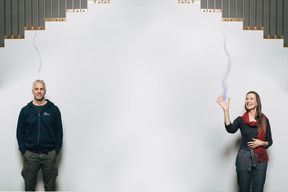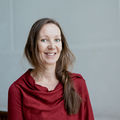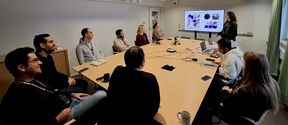Oasis of Radical Wellbeing
Social sustainability in practice.

Maria Joutsenvirta and Jani Romanoff know resilience – that trendy workplace buzzword – both in theory and through practical experience. The term is often used to refer to tenacity or the ability to recover psychologically, but they also see it as an important professional skill that anyone can learn.
But it goes beyond being just a handy skill to pick up. In fact, both Joutsenvirta and Romanoff believe that resilience should be seen as a part of the work community rather than approached as something each of us needs to learn individually.
‘It makes no sense for individuals to try to learn to be more resilient on their own in order to meet the demands of today’s world. Work communities should create conditions where everyone has the space, time, and opportunities to recover – not burn out,’ says Joutsenvirta, a visiting scholar at Aalto University.
‘Many people feel the need to appear strong and confident at work, suppressing their emotions. We beat ourselves up for not being good enough, and we expect the same from others. We rarely tell a colleague that they are doing too much, and should slow down,’ points out Romanoff, professor of marine technology and vice dean at the School of Engineering.
One of the challenges? Joutsenvirta and Romanoff say that most of us have a limited understanding of the scope of our colleagues’ work. In many jobs, people are constantly bombarded with requests from a variety of sources, and work performance is measured with rather narrow metrics.
We can foster a more collaborative approach to resilience, for example, by increasing transparency of everyone’s workloads and ensuring backup personnel are available for crucial tasks in case of illness.
In Jani Romanoff’s research group, everyone creates an annual plan for themselves, which they share with others. This way, the entire team knows when a colleague has a particularly heavy workload.
‘Supervisors can also serve as an important counterforce to an excessively performance-driven mindset. They can question the necessity of unproductive meetings and tasks that contribute very little to the work community,’ Maria Joutsenvirta explains.
‘Absolutely. The wisest advice I have received from a supervisor was to allocate 80 per cent of my working time to actual work. I was scandalised; how could I do that when I get paid for 100 per cent? My supervisor said, “Jani, surprises always account for 20 per cent – and if by chance they don’t, then use that time for strategic thinking,”’ recalls Romanoff.
Put your phone away. Close your computer. Exercise. Jani Romanoff often shares these tips to students who want to improve their resilience.
‘The harder the problem I’m dealing with, the more I prioritise exercise. When I return to my workstation after training my mind has already solved the problem. I’ve recommended the same approach to many people,’ says Romanoff.
‘I’ve only recently realised that simply urging people to exercise is not enough. Yes, everyone should work out, but resilience can be cultivated in work communities with other methods as well. For example, with collective embodied practices,’ he adds.
Jani Romanoff has served as academic leader in Aalto University’s Oasis of Radical Wellbeing project, which aims at creating holistic wellbeing. Maria Joutsenvirta, in turn, was involved in creating the university’s strategic experiment, Capacity Building of Creative Radicals (CBCR). Both projects have piloted methods for enhancing wellbeing.
Embodied practices, which were explored in the CBCR project, are exercises designed to foster a shared sense of a safe space and self-awareness among individuals, enhancing their ability to tolerate uncertainty. These exercises are based on the systemic change leadership model, U-Theory, developed by researcher Otto Scharmer from the Massachusetts Institute of Technology, and the related methodology of Social Presencing Theater.
‘Embodied exercises help calm the mind, focus on the present, and engage with the emerging reality with brave curiosity. Ideas and insights start to surface that would otherwise remain unrealized,’ explains Maria Joutsenvirta.
‘In the project’s workshops, I clearly noticed how intellectual reasoning provides only one channel for understanding the complexity of the world.’
Joutsenvirta and Romanoff say that listening more to intuition and the body’s signals can help develop communal resilience within work communities.
‘I am a very kinesthetic person. Often, my body tells me that something is wrong before my mind even realizes it,’ says Joutsenvirta.
‘In a safe work environment, people can share their feelings. They can openly express that not everything feels right,’ she adds.
‘Especially in systemic-level problems, you may first get a gut feeling that something is not okay. But very few of us dare say that hey, I have bad vibes about this, even though I can’t explain it or back it up with solid facts,’ says Romanoff.
He adds that intuition has much less credibility in the workplace compared to facts, even though we also do a lot of work in our subconscious.
‘If you don’t react to the warning signs from the subconscious, you often act against your own values – and usually feel bad.’
Joutsenvirta emphasises that in a crisis-ridden world paced by artificial intelligence, work communities need people with both a strong sense of self-knowledge and the ability to take others into account.
‘When we recognise intuitive and emotional messages as important, we gain access to new ways to improve our wellbeing and the overall creativity of the work community,’ explains Joutsenvirta. ‘Unlike artificial intelligence, we can pay attention to more than facts. We have many kinds of intelligence, and the world is opening to exploring things that machines cannot do.’
‘I agree,’ responds Romanoff. ‘All creative work would benefit from reducing stress levels and making more room for emotions. Now that artificial intelligence is already being used to assist us in tedious tasks, I hope we’ll have more time and courage to focus on everyone’s wellbeing and resilience as a community resource.’
Jani RomanoffIf you don’t react to the warning signs from the subconscious, you often act against your own values.


Text: Joanna Sinclair
This article has been published in the Aalto University Magazine issue 33, September 2023.

Social sustainability in practice.

Encourage your team to let go of routines that prevent creativity. Radical Creativity piloted with Social Presencing Theater’s methods.

